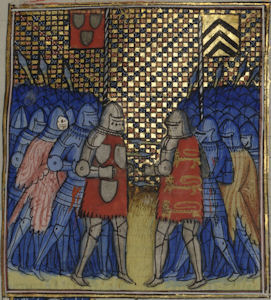The battle at Calais between the French knights who are trying to capture it by a ruse and the English who lie in ambush. The miniature shows two armies of foot soldiers meeting in a field and attacking each other with lances. On the right are the French, led by Geoffroy de Chargny, who is represented with an amorial surcoat and a banner behind him with his arms (gules, three eschutcheons silver). On the right are the English with the English king, Edward III, wearing an armorial surcoat with his arms (gules, three lions passant or) in the front, confronting Geoffrey de Chargny. Above the English army flies the banner of Sir Walter Mauny, who according to Froissart’s text, was in command (or, three chevrons sable). The background is diapered with gold, blue and red with white penwork.
also known as Walter de Manny, Manney, Walter Mauny, Walter the Mawnay, and Gaultier de Mauny
(d. 1372)
Walter Mauny (or Manny), one of the ablest English captains of the HUNDRED YEARS WAR, earned a European reputation for valor and CHIVALRY.
The son of a noble Hainaulter family, Mauny came to England in 1327 in the entourage of his countrywoman, Queen PHILIPPA, wife of EDWARD III. Knighted in 1331, Mauny fought in SCOTLAND in the early 1330s and was appointed admiral of the north in 1337. In the first of many gallant exploits recorded by his fellow Hainaulter, Jean FROISSART, Mauny descended on Cadsand, an island at the mouth of the Scheldt from which French privateers attacked English shipping. During the raid, Mauny single-handedly rescued HENRY OF GROSMONT, earl of Derby, when he was in danger of capture; Mauny also took several prisoners, including the bastard brother of LOUIS DE NEVERS, count of FLANDERS. In 1340, the king, who had already granted Mauny numerous lands and offices, gave him £8,000 for the RANSOM of his Cadsand prisoners.
In 1339, at the start of the THIÉRACHE CAMPAIGN, Mauny, according to Froissart, vowed to be the first to enter France and seize a stronghold, which he did by crossing the Hainault frontier with forty companions and surprising the castle of Thun l’ Evêque. In June 1340, Mauny fought at the Battle of SLUYS and was present later in the year at the siege of TOURNAI. In 1342, Mauny landed in BRITTANY, where, among other adventures, he broke the siege of Hennebon, thereby liberating the wife of John de MONTFORT, the English client in the BRETON CIVIL WAR. In 1345-46, Mauny distinguished himself during Derby’s first two campaigns in GASCONY. In the latter year, while John, duke of NORMANDY, was besieging the Gascon town of AIGUILLON, Mauny released a Norman knight in his custody without ransom in return for a safe-conduct from the duke to travel through France to join Edward for the developing CRE’CY campaign. Despite this safe-conduct, Mauny was attacked and most of his men were captured, although he escaped, thereby adding to his growing reputation.
In 1347, Mauny served at the siege of CALAIS and was one of the English representatives who negotiated the Truce of Calais after the city’s fall (see CALAIS, TRUCE OF). On 31 December 1349, he played a key part in foiling a French attempt to retake Calais by treachery. Leading a small party of knights that included the king and EDWARD, THE BLACK PRINCE, traveling incognito, Mauny ambushed the French as they entered Calais Castle. Uttering the war cry “Mauny to the rescue” to preserve his anonymity, the king led Mauny and his comrades in a nightlong fight that saved the town. During the 1350s, Mauny undertook various military and diplomatic assignments; he fought at the naval Battle of WINCHELSEA in 1350, broke the Scottish siege of Berwick Castle in 1355, and negotiated an extension of the Anglo-French truce in 1359. He accompanied the king during the RHEIMS CAMPAIGN of 1359-60, was one of the English guarantors of the Treaty of BRE’TIGNY in 1360, and was one of JOHN II’s guardians when the captive French king was transferred to Calais. In the 1360s, Mauny served briefly in Ireland and participated in negotiations for a marriage between the king’s son, EDMUND OF LANGLEY, and MARGUERITE, daughter of LOUIS DE MALE, count of Flanders.
Mauny’s service in the war made him both wealthy and famous. Summoned to PARLIAMENT as Lord Mauny in 1347, he became a knight of the GARTER in 1359 and received extensive grants of land in England and AQUITAINE. Although likely exaggerated by Froissart, Mauny’s chivalric exploits were well known on both sides of the Channel. In 1349, he acquired land near Smithfield outside LONDON where fifty thousand victims of the BLACK DEATH were supposedly buried. Mauny later founded a house of Carthusian monks, the London Charterhouse, on the site and was buried in the monastery on his death in January 1372.
Further Reading: Packe, Michael. King Edward III. Ed. L. C. B. Seaman. London: Routledge and Kegan Paul, 1983; Sumption, Jonathan. The Hundred Years War. Vol. 1, Trial by Battle. Philadelphia: University of Pennsylvania Press, 1999.
